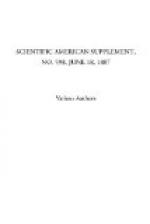Frankly, between the two acquisitions, there is no hesitation possible.
Finally, if we must say so, we do not think that foreign powers, when they believe it their duty to provide themselves with materiel of great caliber, will think of supplying themselves from the Essen works, on account of the memorable accidents due to the imperfection of guns coming from this celebrated establishment. The list of burstings that have occurred, not only in Germany, but also in Russia, Bohemia, Italy, Turkey, and Roumania, is already a long one. To speak here only of what occurred in France in 1870-71, it is certain that out of seventy German guns of large caliber in battery against the southwest front of the wall of Paris, thirty-six—say more than half—were put out of service during the first fifteen days of the bombardment, and that too through firing merely; and it was the opinion of Mr. De Moltke himself that the German siege batteries would have been reduced to silence, had the defenders been able to hold out for a week longer. It is equally certain that, during the course of the Loire campaign, eighty guns of Prince Frederick Charles’ were put out of service by the sole fact of their firing. Summing up the history of these many accidents, the Duke of Cambridge asserted to the House of Lords (April 30, 1876) that two hundred Krupp guns burst during the Franco-German war. Have the engineers of the Essen works improved their processes of manufacture since that epoch? It is permissible to doubt it, seeing that, very recently, the Italian navy refused to take from Mr. Krupp some 151/2 inch guns whose tubes were but very imperfectly welded.
Must the numerous accidents mentioned be attributed to defects in the metal employed? Were they due to defective hooping? Were they due to some one of the numerous inconveniences inherent to the cylindrico-prismatic system of closing (Rundkeilverschluss)?
They were doubtless owing to such causes combined.—La Nature.
* * * * *
COLORS OF THIN PLATES.
The Right Hon. Lord Rayleigh lately delivered a lecture at the Royal Institution upon “The Colors of Thin Plates,” a term which he explained was applied to thin films of substances, such as oily films on the surface of water or the equally familiar soap bubble. Although the reflection of colors from the surface of a soap bubble is probably the most noticeable, yet the “plate” which lends itself most readily for experiment is a film of air confined between two sheets of glass. If a ray of white light be reflected from the surface of the film upon a screen, the so-called Newton’s rings, a series of colored concentric rings, are obtained. If, instead of reflected light, the ray of light transmitted through the film of air be allowed to fall upon the screen, the same phenomenon is observable, but the effect




